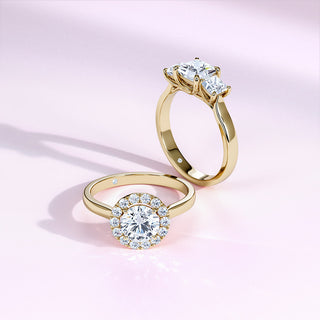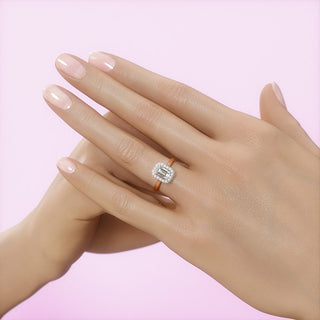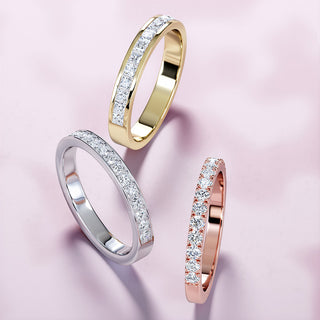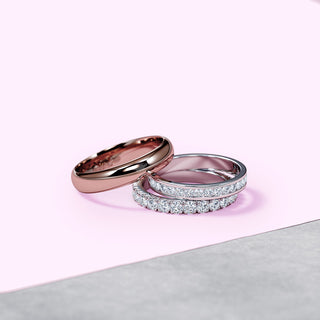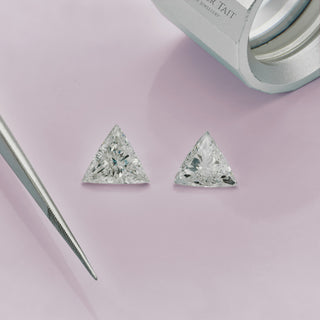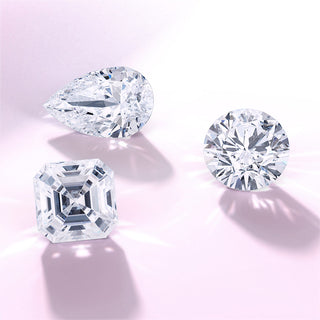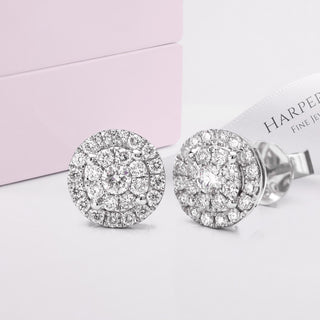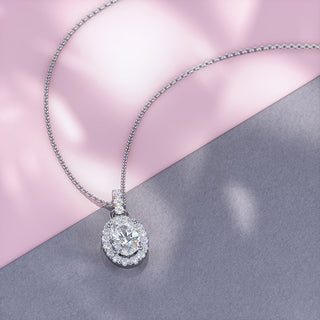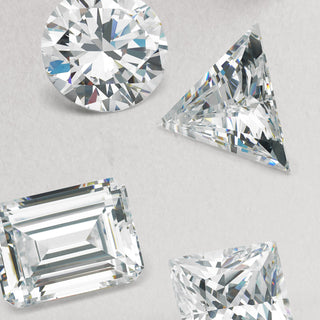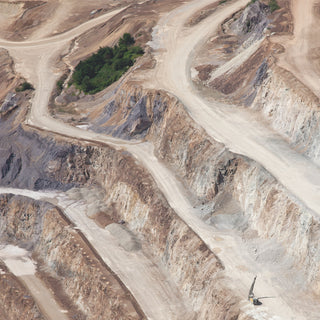Lab Grown Diamonds
As perhaps the most exciting development in the jewellery and gemology worlds for decades, lab created diamonds are quickly growing in popularity. Thanks to their ethical credentials and relative affordability, lab created diamonds can provean interesting alternative to natural diamonds. If you are considering lab diamonds for your engagement or wedding rings, we have all the information you need to make an informed decision. Here is our guide to lab created diamonds.

What are lab created diamonds?
Lab diamonds are diamonds formed above ground rather than inside the earth. They may be also known as created, lab grown, man made, or cultivated diamonds.
They are created in laboratory conditions which replicate the natural process under which diamonds are formed. The result is real diamonds, indistinguishable from their mined counterparts.
What is the difference between lab created and natural diamonds?
Lab created diamonds are physically and visually identical to their mined counterparts. They look the same as natural diamonds. They are cut and polished in the same way as natural diamonds.
Their chemical structure and properties are the same as natural diamonds. The only difference is in how they are made.


Durability
Lab diamonds are as hard and durable as natural diamonds.
A 10 on the mohs scale, they’re just as difficult to scratch or chip as natural diamonds, making them the same perfect choice for precious jewellery.
Both lab and natural diamonds are the quintessential symbol for the strength and longevity of
love.

Price
Thanks to the efficiency of creating lab diamonds, they are significantly less expensive than natural stones. This means choosing lab created diamonds can help your budget go further, whether that means a larger stone in your solitaire, or enhancing your ring with shoulder and melee stones.
Prices for lab created diamonds have fallen since their introduction, and with the introduction of new technology and stones it is conceivable prices could drop further. For this reason there is no guarantee on the future value of any lab created diamond. It’s wise not to consider a lab created diamond an investment with resale value, but to purchase simply for the love of the gemstone and jewellery itself.

The Four C's
Lab created diamonds are graded using the same distinctions are natural stones - cut, clarity, colour, and carat.
As they are grown in the same way as natural diamonds, lab diamonds exhibit the same range of colour and clarity variations. The raw material is cut and polished in exactly the same way as their mined counterparts. Harper Tait diamonds select only the most beautiful and high quality
stones for our jewellery.
How are lab diamonds made?
There are two methods by which lab diamonds can be made - High Pressure-Highn Temperature (HPHT) and Chemical Vapour Deposition (CVD).
HPVT
HPVT was the first methodn developed to create diamonds. A small ‘seed’ of diamond is placed inside a cubic press - essentially a large pressure cooker - which can exert huge amounts of pressure. The seed is joined in the centre of the press by an additional layer of carbon, in the form of graphite. With immense pressure and heat applied, the graphite layer melts, finally being carefully cooled to turn into diamond.
CVD
Our diamonds are primarily created using the CVD method, a carefully developed process to replicate exactly the conditions under which natural diamonds are created. Like HPVT, CVD diamonds are formed from diamonds. Fine diamond slivers are placed into a large vacuum chamber, to which a hydrocarbon gas such as methane is carefully added. High power microwave energy is used to break down the atomic bonds of the gas, separating carbon atoms from hydrogen atoms. The freed carbon settles on the diamond slivers, growing a larger diamond crystal atom by atom. The resulting diamonds share all the wonderful, unique characteristics of stones formed under the earth. Natural inclusions and variations in colour make lab created diamonds as individual as mined stones.
FREQUENTLY ASKED QUESTIONS
Learn about Lab Created Diamonds
Are lab created diamonds sustainable?
One of the key draws of lab created diamonds is theirv sustainability. Thanks to the fact they don’t need to be extracted from the earth, lab created diamonds are considered a more environmentally friendly choice. No earth is displaced or disturbed to produce a lab diamond, and as a new entry to the market they don’t share the historical issues of natural diamonds. However lab diamonds do require energy to create, which is something we’ve considered when sourcing our stones.
We’ve chosen our lab created diamonds as carefully as we do our natural stones. The majority of our lab created diamonds come from a single source, chosen for their rigorous ethical and environmental standards. We’re proud to offer lab created diamonds with a fully transparent supply chain and powered by renewable energy sources.
Is there a difference between a Lab Diamond and CZ or Moissanite?
Imitation diamonds have been around for decades, but lab created diamonds are distinctly different to stones such as cubic zirconia (CZ) and moissanite. Diamond simulants seek to mirror the look of a diamond, but do not share the physical properties of one. Diamonds, whether lab created or natural, are made from carbon. CZ is made from zirconium dioxide, and moissanite from silicon carbide.
The difference affects the stones’ properties and behaviour. For instance, a CZ is much softer than a diamond and has lower refraction, so will not be as durable or sparkle as brilliantly. Moissanite is considered the closest to a diamond in hardness and refraction, but still exhibits a different pattern of sparkle due to silicon carbide’s chemical structure.
What all three have in common is being laboratory created. Although moissanite can be naturally occurring, material suitable for jewellery is rare. For this reason, almost all moissanite engagement rings use lab created stones. As neither CZ or moissanites are genuine diamonds, their price is much less. One of the benefits of lab created diamonds is how they have helped to bridge the gap between inexpensive diamond imitations and natural diamonds. Lab created diamonds offer more for your money while still enjoying the luxury and romance of real diamonds.
Is there a difference between a Lab Diamond and CZ or Moissanite?
Imitation diamonds have been around for decades, but lab created diamonds are distinctly different to stones such as cubic zirconia (CZ) and moissanite. Diamond simulants seek to mirror the look of a diamond, but do not share the physical properties of one. Diamonds, whether lab created or natural, are made from carbon. CZ is made from zirconium dioxide, and moissanite from silicon carbide.
The difference affects the stones’ properties and behaviour. For instance, a CZ is much softer than a diamond and has lower refraction, so will not be as durable or sparkle as brilliantly. Moissanite is considered the closest to a diamond in hardness and refraction, but still exhibits a different pattern of sparkle due to silicon carbide’s chemical structure. What all three have in common is being laboratory created. Although moissanite can be naturally occurring, material suitable for jewellery is rare. For this reason, almost all moissanite engagement rings use lab created stones.
As neither CZ or moissanites are genuine diamonds, their price is much less. One of the benefits of lab created diamonds is how they have helped to bridge the gap between inexpensive diamond imitations and natural diamonds. Lab created diamonds offer more for your money while still enjoying the luxury and romance of real diamonds.
How much do lab grown diamonds cost?
Natural diamonds are some of the rarest and most prized stones on the planet, which is reflected in their cost. Although a lab diamond enjoys all of the same physical and visual properties that make diamonds so beloved, they do not have the same intrinsic rarity of mined stones. They are also much more efficient to produce.
For this reason, lab created diamonds are less expensive than natural stones. We can provide like-for-like quotes on any piece, so you can understand the difference between choosing lab created or natural diamonds for your jewellery.
I have a diamond engagement ring - can I choose a lab created diamond wedding band?
Absolutely. Lab created diamonds are completely identical to natural diamonds, so as long as the colour and clarity grades are matched you will see no difference whatsoever between the stones.
At Harper Tait we only use D-F colour and VS clarity, whether natural or lab created diamonds. Eye clean and colourless, they’re the most beautiful choice for your jewellery.
Are lab diamonds or mined diamonds better for the environment?
Lab diamonds are lauded as the environmentally friendly alternative to mined diamonds. To understand why, we need to look first at how natural diamonds are produced.
Diamonds are created deep within the earth, thanks to the effects of heat, pressure, and time on naturally occurring carbon deposits. To extract the raw diamonds, miners must first dig down through layers of earth to reach them, whether that be on the land or under the sea bed. The process of mining uses physical force and sometimes chemicals, affecting marine, river, and forest life. While processes have improved over the years, mining does have an impact on the surrounding environment.
Lab diamonds seek to mitigate the environmental cost of diamond production by avoiding mining altogether. Of course, lab created diamonds still require resources and energy to produce. While lab created diamonds take less electricity and water to produce than mined stones, replicating the conditions under which natural diamonds are produced is no small matter. With this in mind, we explored the growing range of lab diamonds available to us to find the most sustainable option. We are delighted to have found a partner who uses renewable energy sources to create our diamonds.
When it comes to making ethical decisions, we believe in balancing information and values to make a personal decision. That’s why we provide a choice of both natural and lab created diamonds, and go to great lengths to ensure we offer the most ethical options possible for both. Our natural diamonds are sourced from trusted partners with whom we have long standing relationships. They share our values on quality and ethics, and guarantee that every stone is Kimberley Process compliant.
The Kimberley Process Certification Scheme (KPCS) was established in 2003, with the goal to ensure diamond production and purchasing does not support conflict. To this day, the Kimberley Process is the standard for all natural diamonds, a guarantee that your diamond is conflict-free.
Like many industries, diamonds haven’t always had a history to be proud of. But mining practices are undergoing continual improvement, developments you can be sure we encourage and keep abreast of. We also consider the communities that benefit from diamond mining and processing, thanks to local employment and economic investment. We’re here to help you balance all the factors in making your choice.
Are lab diamonds or mined diamonds better?
We adore diamonds. We love their brilliance, their symbolism, their beauty. They make the most wonderful choice for engagement rings, wedding bands, and fine jewellery, whether glittering melee or a solitaire. And that goes for both natural and lab created stones.
Loose or set in jewellery, a natural diamond and a lab created diamond will look and behave exactly the same. You will enjoy the same incomparable fire and sparkle, and know you have chosen the most precious and durable stone to symbolise your forever love. So choosing between lab created and natural diamonds comes down to a few personal preferences.
Do you adore the rarity and romance of a natural diamond, formed over millions of years inside the earth? Or do you love the thought your diamond was created above ground, without disturbing that earth?
Would you prefer a natural diamond above all, or would you like your budget to go a little further, perhaps to a halo or a larger stone?
At Harper Tait, everything we do is driven by you. That’s why we offer the choice between lab created and mined diamonds in all our pieces, whether our signature lines or bespoke. We’ll happily provide a like-by-like quote to help you understand your options
If you’d like to talk your choice over further, feel free to reach out to our gemologists/expert team on EMAIL Or explore our collection of lab created diamond engagement rings.


